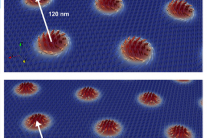A connection between condensed matter physics and materials science
Fri, 11/16/2018 - 9:16amA new publication in Nature Scientific Reports brings together condensed matter physics and materials science. A team based in ETH Zurich, the University of Manchester, and now UL Lafayette, led by new UL Lafayette Physics faculty member Dr. Michalis Charilaou, seeks to unravel the effects of defects on topological magnetic phases, specifically skyrmion lattices. Skyrmions are particle-like magnetic textures that form due to competing interactions, and their spin winding bestows them with unprecedented topological stability, making them highly promising candidates for non-volatile memory and logic devices. In their article, the team shows for the first time compelling evidence that defects in magnetic materials have a critical impact on skyrmion phase transitions. Specifically, they show that in perfect materials a skyrmion lattice inverts its polarity through a field-induced first-order topological phase transition that involves a dynamic creation and annihilation of skyrmion-antiskyrmion pairs. In striking contrast, they observe that in the presence of even a single defect individual skyrmions are gradually annihilated by external fields; leading to a second-order melting-like phase transition through which topological charge is gradually lost. These findings have an important impact in that they demonstrate how defects in real materials can prevent us from observing the physics of topological phases. The insight on defect-induced topological melting is a prerequisite in tailoring functioning skyrmion devices for the upcoming wave of skyrmion electronics.

